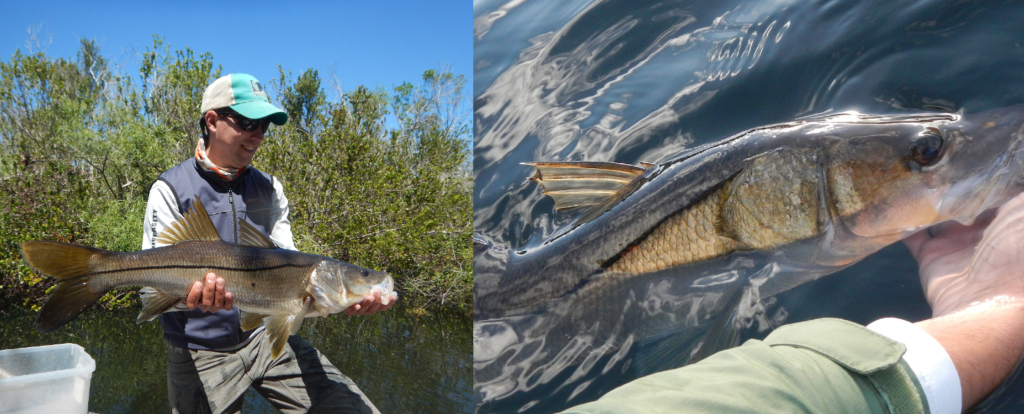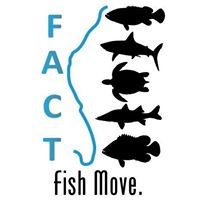
Right: Common Snook. Photo Credit: Jordan Massie
Project Overview
In South Florida, there is a constant debate over how the limited supply of freshwater is distributed to meet different needs while also protecting residents from the damage caused by storms and flooding. South Florida shares the demand for freshwater between the needs of cities and communities, agriculture, and the water required to preserve the natural environment. Recreational fisheries are one very important benefit of healthy ecosystems, providing over 8 billion dollars to Florida’s economy each year. What is currently unknown is how the amount of freshwater going into coastal ecosystem like Everglades National Park affects these valuable recreational fisheries.
Previous research at Florida International University has shown that seasonal rainfall patterns and changes in the amount of freshwater released into the Everglades create spikes in prey availability for highly targeted recreational fish such as Common Snook (Centropomus undecimalis) and Largemouth Bass (Micropterus salmoides). Based on this finding, our research is addressing two important questions:
1) How far do snook and bass move to take advantage of this extra prey?
2) Do these spikes in prey availability affect reproduction, and increase the number of young a fish can produce?
To answer these questions, we are using acoustic telemetry to track the movements of snook and bass from the headwaters of the Shark River to the Gulf of Mexico in the Florida Coastal Everglades. We can then compare the timing of these movements to freshwater flows, seasonal increases in prey, and how these factors affect fish populations from year-to-year.
Why this Matters
Data provided by this study is the first step in understanding the importance of freshwater flows to coastal fisheries in South Florida. The research will provide insight into how fish respond to seasonal increases in prey availability and how this can boost fish populations. The information generated from this study is important to the recreational fishing community and provides data that allows water managers make decisions that help preserve angling opportunities.
Lead Organizations
- Florida International University
- Florida Coastal Everglades Long Term Ecological Research Program FCE LTER
Partners
Supported by
- Florida Coastal Everglades Long Term Ecological Research program (funded by grant from the National Science Foundation)
- U.S. Army Corp of Engineers RECOVER program
Project Status
- Ongoing: Array includes 25 new VR2W receivers in January 2022 to replace old receivers
- FACT Project Codes:
- SRFCE (tags)
- SRFCEA (array)
- FACT Project Codes:
Contact
Resources & Publications
- Boucek, R., A. Trotter, D. Blewett, J. Ritch, R. Santos, P. Stevens, J. Massie, and J. Rehage. 2019. Contrasting river migrations of Common Snook between two Florida rivers using acoustic telemetry. Fisheries Research 213: 219-225.
- Boucek, R.E., M.R. Heithaus, R. Santos, P. Stevens, and J.S. Rehage. 2017. Can animal habitat use patterns influence their vulnerability to extreme climate events? An estuarine sportfish case study. Global Change Biology.
- Boucek, R.E., M. Soula, F. Tamayo, and J.S. Rehage. 2016. A once in 10 year drought alters the magnitude and quality of a floodplain prey subsidy to coastal river fishes. Canadian Journal of Fisheries and Aquatic Sciences 73: 1672-1678.
- Massie, J.A., B.A. Strickland, R.O. Santos, J. Hernandez, N. Viadero, R.E. Boucek, H. Willoughby, M.R. Heithaus, and J.S. Rehage. 2019. Going Downriver: Patterns and Cues in Hurricane-Driven Movements of Common Snook in a Subtropical Coastal River. Estuaries and Coasts: 1-16.
- Matich, P., J.S. Ault, R.E. Boucek, D.R. Bryan, K.R. Gastrich, C.L. Harvey, M.R. Heithaus, J.J. Kiszka, V. Paz, and J.S. Rehage. 2017. Ecological niche partitioning within a large predator guild in a nutrient‐limited estuary. Limnology and Oceanography 62: 934-953.
- Matich, P., and M.R. Heithaus. 2012. Effects of an extreme temperature event on the behavior and age structure of an estuarine top predator, Carcharhinus leucas. Marine Ecology Progress Series 447: 165-178.
- Matich, P., and M.R. Heithaus. 2014. Multi‐tissue stable isotope analysis and acoustic telemetry reveal seasonal variability in the trophic interactions of juvenile bull sharks in a coastal estuary. Journal of Animal Ecology 83: 199-213.
- Matich, P., and M.R. Heithaus. 2015. Individual variation in ontogenetic niche shifts in habitat use and movement patterns of a large estuarine predator (Carcharhinus leucas). Oecologia 178: 347-359.
- Rezek, R.J., J.A. Massie, J.A. Nelson, R.O. Santos, N.M. Viadero, R.E. Boucek, and J.S. Rehage. 2020. Individual consumer movement mediates food web coupling across a coastal ecosystem. Ecosphere 11: e03305.
- Rosenblatt, A.E., and M.R. Heithaus. 2011. Does variation in movement tactics and trophic interactions among American alligators create habitat linkages? Journal of Animal Ecology 80: 786-798.
- Rosenblatt, A.E., M.R. Heithaus, M.E. Mather, P. Matich, J.C. Nifong, W.J. Ripple, and B.R. Silliman. 2013. The roles of large top predators in coastal ecosystems: new insights from long term ecological research. Oceanography 26: 156-167.
- Stevens, P., D. Blewett, R.E. Boucek, J.S. Rehage, B. Winner, J. Young, J. Whittington, and R. Paperno. 2016. Resilience of a tropical sport fish population to a severe cold event varies across five estuaries in southern Florida. Ecosphere 7: e01400.
- Strickland, B.A., K. Gastrich, F.J. Mazzotti, J.A. Massie, V. Paz, N. Viadero, J.S. Rehage, and M.R. Heithaus. 2020. Variation in movement behavior of alligators after a major hurricane. Animal Biotelemetry 8: 1-10.
- Strickland, B.A., J.A. Massie, N. Viadero, R. Santos, K.R. Gastrich, V. Paz, P. O’Donnell, A.M. Kroetz, D.T. Ho, J.S. Rehage, and M.R. Heithaus. 2019. Movements of Juvenile Bull Sharks in Response to a Major Hurricane Within a Tropical Estuarine Nursery Area. Estuaries and Coasts.
